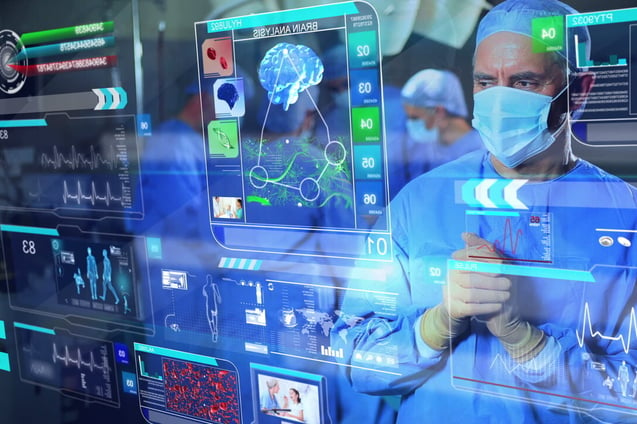AI and Machine Learning in X-rays: Revolutionizing Medical Imaging
The medical imaging industry has always been at the forefront of technological innovation, and with the rise of Artificial Intelligence (AI) and Machine Learning (ML), there’s a significant shift happening in how radiologists interpret X-ray images. These technologies are transforming not just how we see inside the human body, but how we understand it. In this post, we’ll explore how AI and ML are shaping the future of X-ray technology, improving diagnostic accuracy, and enhancing patient care.
3/1/20254 min read


What Is AI and Machine Learning in X-rays?
Artificial Intelligence (AI) is a state in which computers are made to replicate human intelligence, and Machine Learning (ML) is a subset of AI where computers learn from experience and improve without programming for improvement. Used in X-rays, AI and ML software learn to identify patterns in images and data to assist radiologists in the identification of abnormalities, better diagnosis, and even predicting future problems before they become critical.
The Role of AI and ML in X-ray Imaging
AI and ML algorithms are being used in medical imaging devices, i.e., X-rays, to create automatic procedures and also enhance diagnostic outputs. Here's how they're doing that:
Enhanced Image Analysis
X-ray pictures are easier and more accurately interpreted by AI and ML programs than radiologists can within some instances. They can also detect small pathology or patterns too subtle for human vision, such as incipient cancers, broken bones, or lung infections such as pneumonia. AI and ML programs assist the radiologist in highlighting potential faults, allowing the radiologist to concentrate on those of the most importance and limit human mistakes.Improved Diagnostic Accuracy
Artificial intelligence applications have been modeled using huge amounts of data, for instance, thousands of X-rays, so that they could learn to diagnose specific conditions. Through deep learning, AI may even diagnose some difficult conditions more accurately than the traditional methods. This reduces misdiagnosis and leads to better treatment planning. For instance, AI-assisted software has been found to accurately diagnose some conditions like tuberculosis or breast cancer in comparison to radiologists.Faster Interpretation
Time is generally of the essence when diagnoses for life-threatening conditions are being made. AI and ML technology can reduce the time spent interpreting and analyzing X-ray scans by a significant period of time. Direct results can be conveyed to radiologists, allowing them to make faster decisions and deliver sooner treatment. In emergency care facilities, haste is especially critical because haste can literally be a matter of life and death.Predictive Analytics
The most exciting application of AI for X-rays is probably predictive analytics. Predictive analytics via machine learning can not only be applied to find existing conditions but also predict potential threats in the future. For example, AI can assess the progress of a disease or predict that a patient will get a certain condition by analyzing their X-ray history and medical information. This allows intervention and prevention at an earlier moment in time.Assistive Technologies for Radiologists
AI is never intended to substitute radiologists but as an assistant. They are assistive devices that are programmed to make medical doctors' decisions more educated, automate their work, and avoid exhaustion. For instance, AI can serve in triaging cases so that the radiologist can prioritize patients and have the worst cases first.Integration with Other Technologies
AI and ML are not limited to X-ray diagnosis. AI and ML can be integrated with other diagnostic equipment, such as MRI or CT scans, to develop a better, more comprehensive understanding of a patient's health. The integration of several imaging technologies and the ability of AI to compile and process large sets of data are enabling more precise, personalized medicine.
The Impact on Healthcare
The utilization of AI and ML in X-ray imaging yields a number of benefits to healthcare systems, clinicians, and patients:
Cost Efficiency: AI systems can reduce the cost of medical imaging by improving diagnostic efficiency and reducing the need for repeated scans.
Access to Remote Areas: Remote or undeveloped areas with no specialist radiologists can benefit from AI-based X-ray machines. AI has the capacity to interpret photographs in real-time, providing rapid results to doctors and allowing them to make life-or-death decisions.
Reducing Physician Burnout: AI will perform mundane jobs such as image examination, leaving radiologists with more complex cases, thus reducing their workload and lessening doctor burnout, which is a common phenomenon in the health sector.
Challenges and Ethical Considerations
While the future of AI and ML for X-rays appears promising, challenges and ethical considerations must be resolved:
Data Privacy: AI solutions are based on large data sets, which involve sensitive patient information in the majority of instances. Proper anonymization and data breach protection are of utmost importance.
Bias in AI Algorithms: No AI algorithm is greater than its training data. If the dataset used to train an AI algorithm is biased or unrepresentative, then it is likely that there may be areas where the algorithm may not work as efficiently as it would in all demographic groups. This implies that the results can be incorrect or biased.
Regulation and Standardization: As there is greater integration of AI in the health sector, it is essential that these technologies go through rigorous regulatory standards. The regulatory bodies should keep pace with the pace of innovation to provide a patient safety assurance.
Looking to the Future
The prospects of ML and AI in X-rays are very promising. As technology continues to advance, better instruments will become available that not only enhance the diagnostic capability but also complement well with a wider healthcare technology system. These improvements in technology will go a long way in achieving improved patient outcomes, reducing healthcare costs, and medical imaging made available to the whole world.
Radiologists, doctors, and patients can all benefit from the combination of human ability and the combined strength of AI, for a healthier more productive and more efficient health care system.




Reference Website Link:
National Institute of Biomedical Imaging and Bioengineering (NIBIB) - AI in Medical Imaging
Link: https://www.nibib.nih.gov/science-education/science-topics/artificial-intelligence
The Radiological Society of North America (RSNA) - Artificial Intelligence in Radiology
AI and Machine Learning in Healthcare - Stanford Medicine
Radiology Artificial Intelligence Lab - Massachusetts General Hospital
Link: https://www.massgeneral.org/radiology/research/radiology-artificial-intelligence
Health IT Analytics - AI in Radiology
Link: https://healthitanalytics.com/news/ai-in-radiology-improving-image-analysis-and-clinical-decisions
